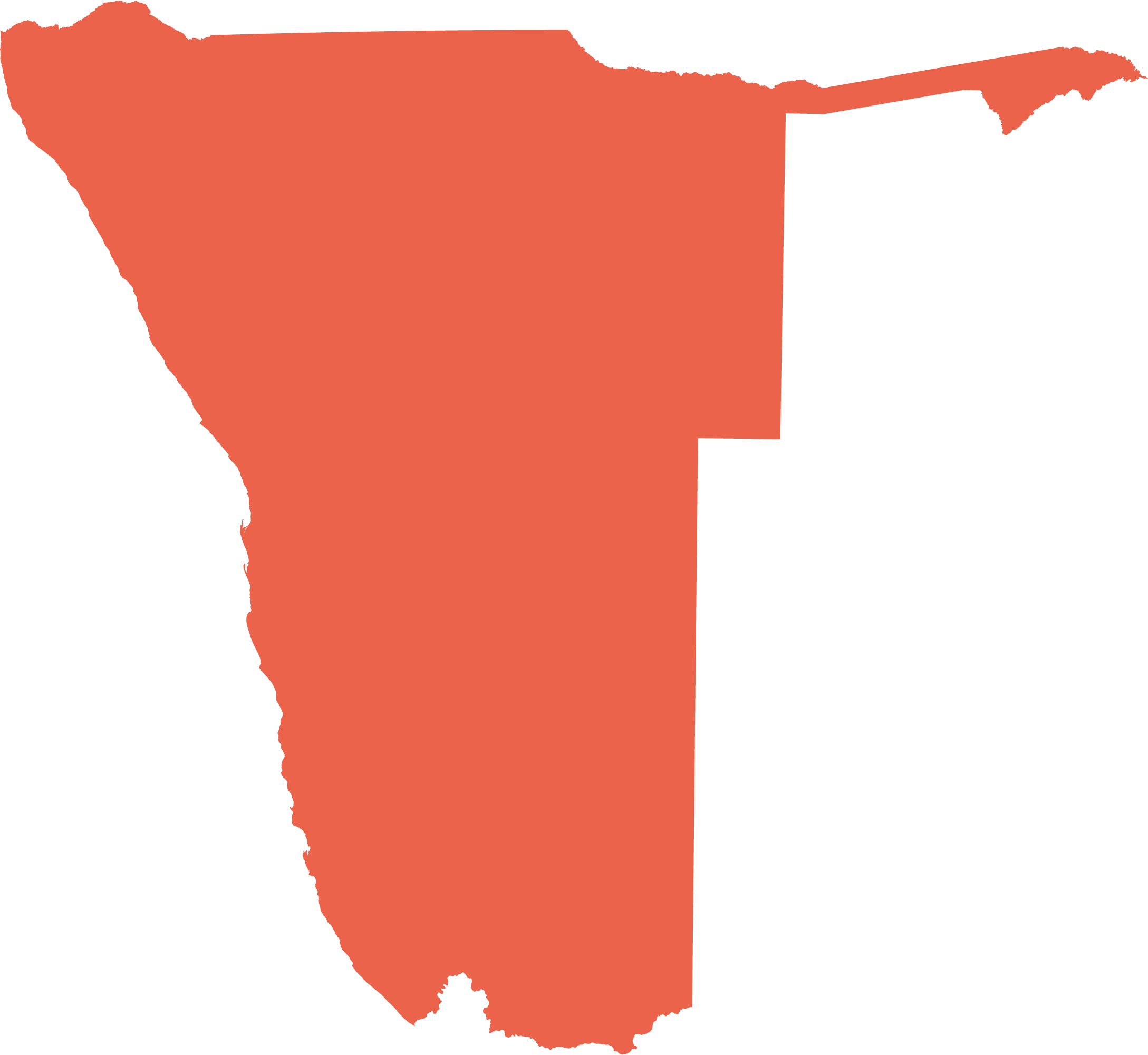10.26 Proportions of households cooking with wood and electricity, 201129
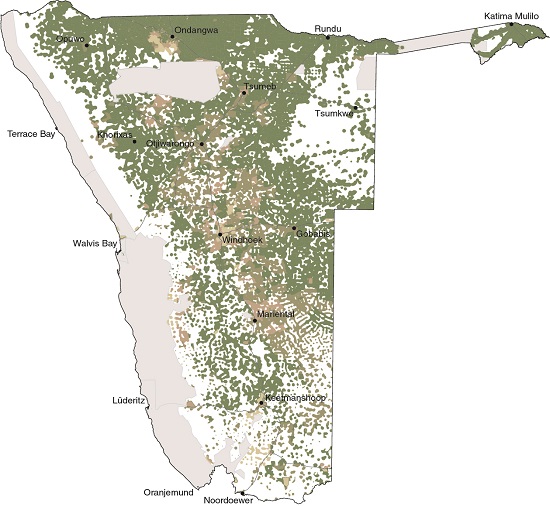


Wood (first map above) is predominantly used for cooking in the northern half of Namibia, and in communal areas where at least 75 per cent of homes cook with wood; unlike elsewhere in Africa, charcoal is seldom used for cooking or heating in Namibia. The use of electricity for cooking (second map above) is concentrated in urban areas and in freehold or commercial farming areas of Namibia.
10.27 Changes in the use of fuel for cooking, 1991–201630
Namibia

Urban

Rural
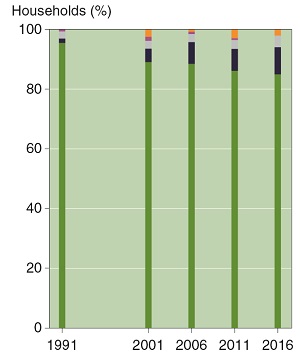

Nationally, the use of wood decreased by almost a third from its use in 74 per cent of homes in 1991 to 50 per cent in 2016. Over the same period, the use of electricity almost doubled from 18.4 per cent of homes to 34.7 per cent; that of gas from 7.1 per cent of homes to 11.9 per cent; and paraffin from 0.8 per cent of homes to 2.0 per cent. In rural areas wood remains the dominant fuel used for cooking, although its use gradually declined from 95 per cent of homes in 1991 to 85 per cent in 2016.
10.28 Percentage of households using electricity for lighting, 201131

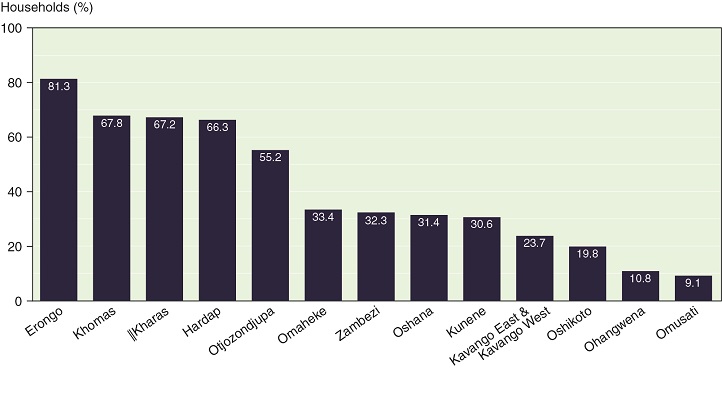
In 2011 more than half of all households used electricity for lighting in Erongo, Khomas, ||Kharas, Hardap and Otjozondjupa, whereas a third of households, at best, in the other regions used electricity for this purpose. In Namibia's urban areas some 70 per cent of households then used electricity, almost five times more than the 15 per cent of rural houses.
In 2016, the Electricity Control Board estimated that there were 219,380 grid-supplied domestic customers (households) nationally, which amounted to only 42 per cent of an estimated 521,000 households in Namibia. In addition, 3 per cent of households were using private sources of off-grid electricity.
10.29 Percentage of households using candles for lighting, 201132
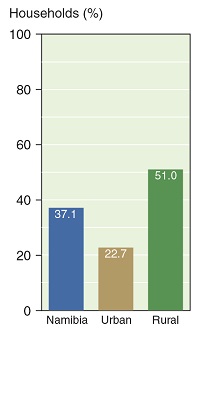

Candle lighting predominates in rural households, especially in Kavango East, Kavango West, Zambezi and Ohangwena regions. Paraffin, wood, solar, battery-powered lights and cell phones are also used for lighting.
10.30 Namibia's wind energy potential33

Wind can be used to generate electricity along most of the coast and in select inland locations. By 2021, two wind farms had been constructed in Namibia: at Lüderitz and Elizabeth Bay. The electricity generated by these wind farms is sold and fed into the national grid. Additional medium- and large-scale wind power plants are expected to become operational by 2030, particularly in southwestern Namibia.

Photo: R Hopperdietzel
Namibia has one of the best solar irradiation regimes in the world. It can generate electricity, for example by using solar photovoltaic technology or a concentrating solar power plant, and solar thermal technologies can be used for heating. In the past few years, the use of the sun's energy to produce electricity has increased rapidly in Namibia. This solar plant powers the Ohorongo cement factory, north of Otavi. The company has also experimented with the use of second-hand tyres and wood chips from encroacher bush to fire its kilns instead of imported coal.
10.31 Independent power producers, 202134
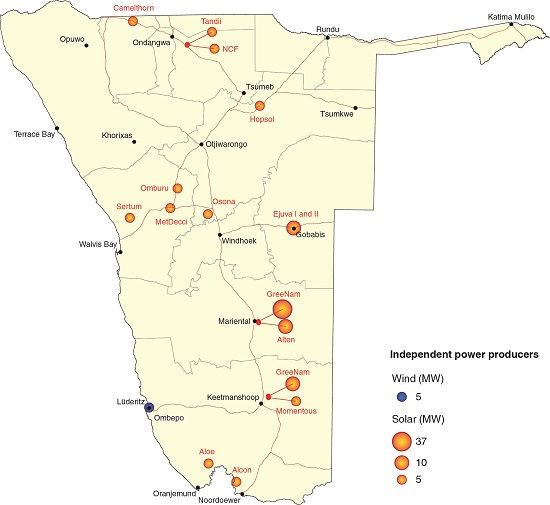
By May 2021, 17 private, non-government, commercial independent power producers contributed 126.5 megawatts of generating capacity to the national electricity grid; these exclude power plants that produced electricity for their owners' consumption. The following renewable and non-renewable energy resources exist in Namibia, but are not (yet) used locally:
- Ocean waves: Namibia's coastline offers potential sites to utilise wave energy, but their feasibility has yet to be quantified.
- Waste: Municipal and other sources of waste could potentially be used to generate heat and electricity. Disposal sites at Namibia's main towns would be ideal for such energygenerating plants.
- Subterranean heat: Evidence of geothermal potential is found at various places across Namibia, for example |Ai-|Ais, Windhoek, Gross Barmen, and Rehoboth, but the scale of these resources remains largely unknown.
- Reserves of natural gas have been found offshore in the Atlantic Ocean, but their commercial development remains elusive because viable markets for the gas have yet to be secured.
- Coal: The use of coal deposits in Namibia, such as those near Aranos, is not commercially viable with current technologies.
- Oil: Commercially viable oil reserves have not been discovered even though there are indications that exploitable resources potentially exist in various areas; exploration activities continue.
